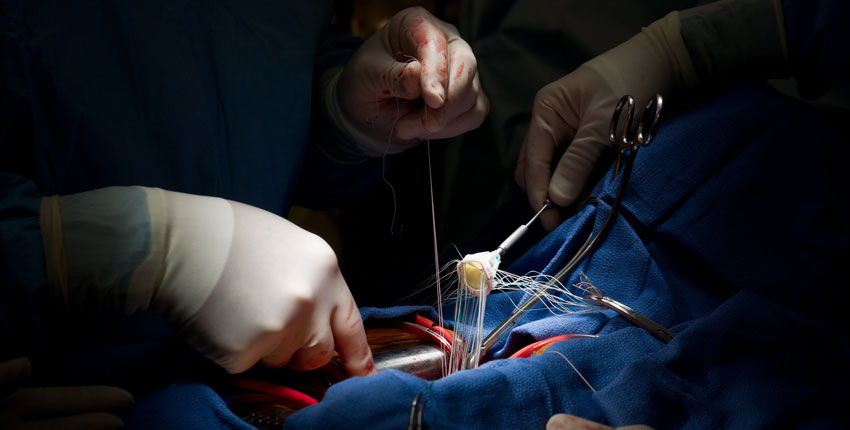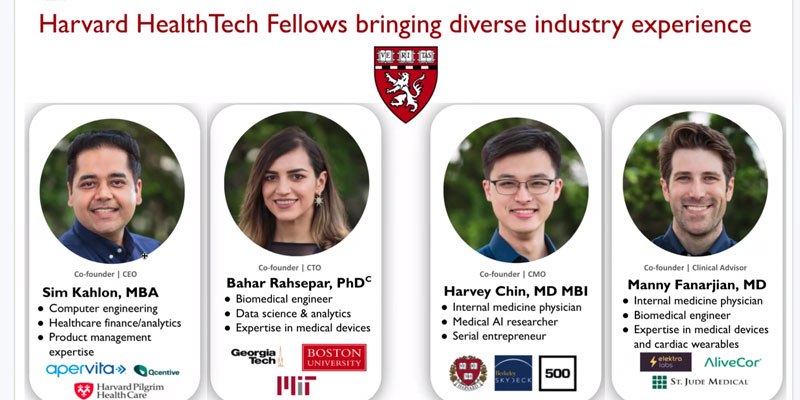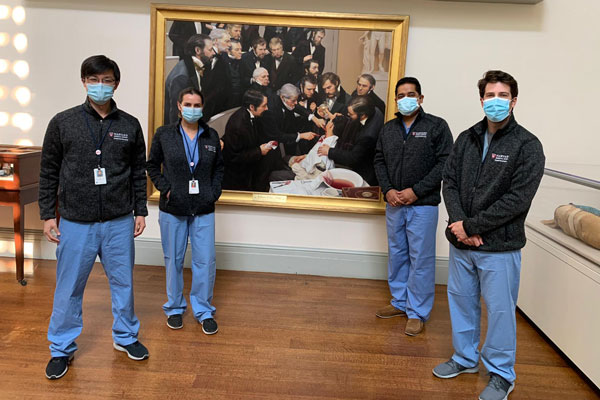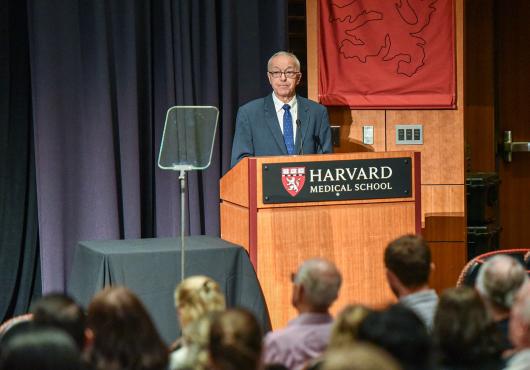
Sim Kahlon is an experienced health care innovator with a computer engineering degree and an MBA in finance. When he became one of the first participants in Harvard’s new HealthTech Fellowship program last fall, however, he soon realized he was embarking on an educational experience unlike anything he’d previously encountered.
That realization hit home when he observed a heart transplant surgery firsthand, as a member of a four-person team of interdisciplinary fellows enrolled in an intensive, two-month immersion in the Division of Cardiac Surgery at Massachusetts General Hospital.
“They would be waiting for the donor heart to arrive so they could quickly pick up the heart and put it in the body,” Kahlon said.
Kahlon was amazed to see a patient’s body with an empty chest—no heart inside. The surgeons’ ability to physiologically support the patient as they waited for a new heart to arrive, he felt, was a testament to modern medicine.
To minimize the potential for delays upon receiving a donor heart, the surgical protocol is to support a patient on an artificial heart-lung bypass machine until the donor heart becomes available.
Although the surgery is highly coordinated, Kahlon said time seemed to crawl while the patient remained completely reliant on the artificial support systems, all the while under constant surveillance. The experience was an epiphany of sorts for Kahlon.
“Just to ponder the miracles of science, and how critical the need is for innovation … to keep pursuing, to keep pushing to develop, to make sure there are inventions happening all the time. Because without a heart bypass machine, this would not have been possible,” he said.
Observing the surgery provoked other questions for Kahlon, who wondered where the donor heart was coming from and what would happen if it was delayed.
“All these questions are going through my mind,” he said. “And I’m thinking, ‘What happens if the donor heart that’s on the way meets with an accident … and this person is lying on the table without a heart?”
For Kahlon and his colleagues in the program—Bahar Rahsepar, Harvey Chin, and Manny Fanarjian— the program’s clinical immersion experiences, such as this one, were designed to prompt just that kind of thinking.
Identifying a need
The 10-month fellowship program, a collaborative effort between Harvard Medical School, the Harvard John A. Paulson School of Engineering and Applied Sciences, and Harvard Business School, embeds participants at Harvard-affiliated hospitals with the goal of having the fellows identify and characterize unmet health care needs through direct observation.
Screening those needs based on factors including clinical impact and potential market, the fellows then brainstorm and iterate novel solutions. The aim is to develop the skills to lead health care innovation, transform challenges into viable business opportunities and, ultimately, improve health care for all.
“We hope to spur innovation with our clinical partners as well as within our clinical partners,” said Paola Abello, director of innovation at the HMS Center for Primary Care who oversees the program.
The fellows began their work by conducting in-person observations for eight weeks. From that effort, they identified more than 370 health care problems for about 20 disease states, Abello said. They then narrowed their list down to the five they were most interested in pursuing.
“The point is to understand what the real need is, right? Because you could have a really fabulous solution, but if you’re not addressing the right problem, it’s not going to take you very far,” said Abello.

Although the HealthTech Fellowship program falls within the HMS Therapeutics Initiative, right now its focus is on improving health care delivery rather than drug discovery, specifically focusing on potential improvements in digital health and medical technology. The program utilizes the biodesign innovation framework to identify problems that need solutions, landing on a project they believe could address a real need.
“They are working on congestive heart failure, and how patients can more efficiently monitor their medications and fluid levels from home,” Abello said. “The inability of patients with congestive heart failure to monitor these things is a huge reason why many end up back in the hospital.”
“We’ve talked to probably over 50 experts to date. And everybody’s agreed that this is a problem that needs to be solved,” said Chin, one of the four fellows.
A physician with a master’s degree in biomedical informatics, Chin has started two health tech companies that employ artificial intelligence to solve problems
“I think as a physician, you always feel like things can be better,” he said. “When you are in med school, you learn a lot of medical knowledge. You memorize, … you learn about the cutting-edge scientific results, but there’s a missing piece between new innovation and actually making an impact on the patient side.”
Significant research funding can go into developing solutions for problems that ultimately are not adopted by the health care system or physicians, Chin said. The solution is not something people really want or need
“My main motivation is learning about how to think about the business side of medicine more structurally,” he said.
A better way
Fellowship participant Manny Fanarjian is a physician and a biomedical engineer who did his residency in internal medicine.
“I can’t tell you the number of times you run into a hurdle or an inefficiency or a gap in the way that care is delivered,” he said. “And you just think to yourself, ‘There’s got to be a better way to do this.’”
The fellowship provided Fanarjian with focused time to think about those kinds of health care problems and an opportunity to try to solve at least one of them.
For example, Fanarjian said, silos in health care systems create difficulties when a patient gets an MRI at a hospital in one health care system and then gets transferred to another hospital in a different system. Providers might not have access to the previous imaging, or they find that lab results and information get shared in an inefficient way—or not at all. Often, the imaging scan just gets repeated in the new hospital, he said.
“And that comes in at a cost to the system and a nuisance to the patients, and potentially, you know, more radiation exposure, depending on what kind of scan it is,” he said, adding that “the entire [health care] system is not built in a patient-centric way.”
“Patients who have multiple chronic comorbidities, they literally plan their lives around their medical care. And it doesn’t serve them that well,” Fanarjian said.
Fanarjian said there are tools that allow blood pressure monitoring from a patient’s home, and even dialysis can be done from home now. But more work needs to go into finding and scaling additional solutions. The fellowship provided him with further expertise.
“There’s a lot of skills that I learned that I just didn’t have before, around patent writing and some product design, stakeholder interviews and market research, and pitching to investors. These are all things that are really important in developing new technologies that I just didn’t have access to before,” he said.

Another benefit to the program was working closely with the three other fellows who all have a diverse range of experiences in health care, medicine, and science. His colleague, fellow Bahar Rahsepar, for example, has a PhD in biomedical engineering.
Rahsepar’s work has involved neural engineering—how memories might be modulated in relation to stress disorders. Primarily focused on basic science research, she was interested in learning more about translation, that is, how to take her discoveries from bench to bedside.
“Different strategies that could be employed in translating basic science research into actual impactful results for patients. That’s the broad category of what I’m interested in,” she said.
For the fellows group, she said, one of the key questions was ‘What is the impact for patients?’
‘It’s like, if you solve this, would there be time saved? Would quality of life be improved for patients? All of those questions come into consideration,” Rahsepar said.
The coronavirus pandemic, she added, also played a role in the group’s ultimate decision to concentrate on improvements to congestive heart failure care. As the pandemic led to a wider use of telemedicine, the possibilities surrounding home monitoring and care became more apparent.
Abello said this first fellows pilot group has already sparked industry interest, especially among investors in the venture capital community, she said.
“If they’re able to launch and develop a product for congestive heart failure patients, that’s a huge community of patients that will be served,” she said.
In fact, Abello said, it was an entrepreneur who provided the initial funding to support the fellowship program which, at this point, is completely supported by philanthropy.
“[Investors] see this as an opportunity to cultivate a pipeline of really strong talent that will stay in Boston,” she said. “But in order to grow this program, we need to continue getting support to be able to educate these future entrepreneurs and innovators.”





